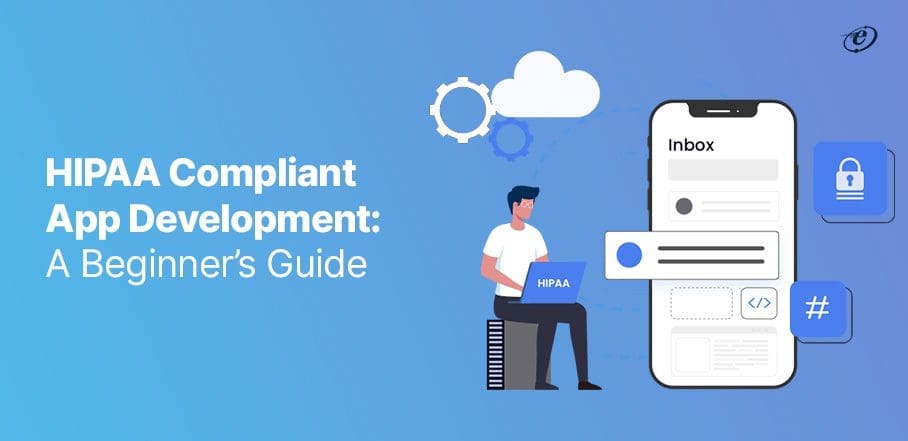
HIPAA Compliant App Development: A Beginner’s Guide
Along with great business opportunities, the emergence of the internet also brings threats and perils. You all agree that Google is more familiar to you than your mother. Today, as we all know, any application will only function once you provide your data.
Due to sensitive data leaks, companies may incur damages of tens or even hundreds of millions of dollars. Particularly in the healthcare sector, there is a significant possibility that third parties will utilize patient information and engage in illicit activity. HIPAA compliant app development is an excellent step against data breaches in such situations.
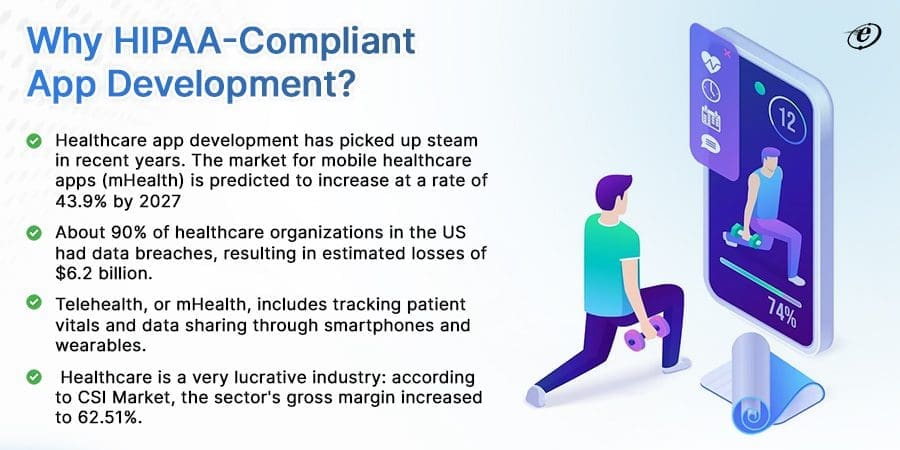
HIPAA compliant app development refers to a set of fundamental guidelines that must be followed during healthcare app development. The market will only accept your healthcare IT solutions if you follow these guidelines.
During and after Covid-19 now, more medical services have been provided through remote platforms, proving these healthcare IT solutions improve patient care. HIPAA compliant app development is crucial for an Android or iOS device to protect confidential patient data.
Many of you consider HIPAA a certification that you will get for your healthcare mobile applications.
Correct!

Since no one provides a HIPAA certificate, you won’t receive one. Healthcare IT solution providers must consider all the HIPAA guidelines while developing their applications.
An example of HIPAA compliant app development is- All health-related apps that handle private patient information require a password.
A great way to enter the lucrative healthcare market is through HIPAA compliant app development. Healthcare mobile app development companies must follow to maintain the confidentiality and security of electronically protected health information (ePHI).
So how to successfully finish the HIPAA compliant app development process? We have gathered our years of expertise in HIPAA compliance application development in this post.
We will first start with a basic understanding of the concept of HIPAA, then an important checklist to achieve HIPAA compliance application development.
What is HIPAA?
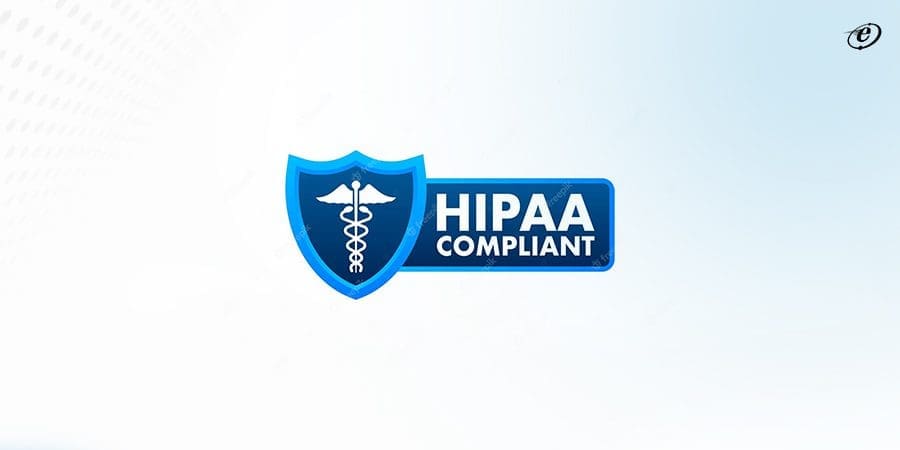
The full form of HIPAA is Health Insurance Portability and Accountability Act. It was first established in 1996 to regulate the healthcare sector in the United States. It is a federal law that requires the development of national standards to stop the publication of private patient health information without the patient’s knowledge or consent.
Privacy and confidentiality are two crucial concepts in patient care that form the foundation of the HIPAA Act. Since the act was written in the pre-digital era, it has undergone numerous expansions. This notable law generally offers the following:

The type of entity using the app and the kind of data it covers determine if your healthcare IT solutions need to be HIPAA-compliant. HIPAA governs healthcare providers, clearinghouses, commercial partners, and health plans. The primary legal acts to achieve HIPAA compliant app development are
Rules of HIPAA
- HIPAA Privacy Rule – to protect PHI privacy;
- HIPAA Enforcement Rule- penalties for HIPAA infractions are outlined
- Breach Notification Rule- requires a breach notification when unsecured PHI is compromised.
- Omnibus Rule- is the last legislation that reinforces the authority of the other statutes.
- HIPAA Security Rule- administrative, physical, and technical measures are required
HIPAA specifies rules to ensure the privacy, reliability, and accessibility of healthcare IT solutions. Two things matter under privacy. One is that the details are kept private, and the second is it needs to be maintained.
What kind of information you’ll retain and transfer through your application is the first thing you must determine when creating a Healthcare IT solution for the US market. Information comes in two forms:
-
Protected Health Information (PHI)
Every element of patient information is included in PHI or public health information. Any covered entity or business associates of the covered entity can use, store, maintains, or share this information.
Covered entities include- Health plans, clearinghouses, and providers who electronically communicate any health information in conjunction with transactions for which the Department of Health and Human Services (HHS) has developed guidelines.
Any person who safeguards gathers, retains, or communicates protected information on behalf of a covered entity is a business associate.
Now, if you want to create a HIPAA-compliant application, it would run and function in accordance with the PHI standards. Whether the app is in an edge condition or not, HIPAA applies as soon as PHI is involved.
The US Department of Health and Human Services defines PHI as 18 types of personal information paired with health data.
-
Consumer Health Information (CHI)
In Consumer Health Information, data is not transmitted to the covered entities, which is the primary distinction between PHI and CHI. It is utilized in digital solutions where the information is only used for personal physical health monitoring and is not shared with any outside parties.
The greatest IT products in this category are user activity-tracking apps like FitBit, Google Health, and others. Because the consumer’s sensitive data is not shared with outside parties, developing digital devices like fitness trackers does not necessitate strict compliance with HIPAA.
Let’s talk about what HIPAA signifies for patients and hospitals before looking into how to get HIPAA compliant app development.
What are the benefits of HIPAA Compliant App Development for Patients & Hospitals?
HIPAA is essential for both patients and healthcare providers. It was put into place to help safeguard sensitive data and ensure that its sharing and processing are carefully regulated.
Benefits of HIPAA for Patients
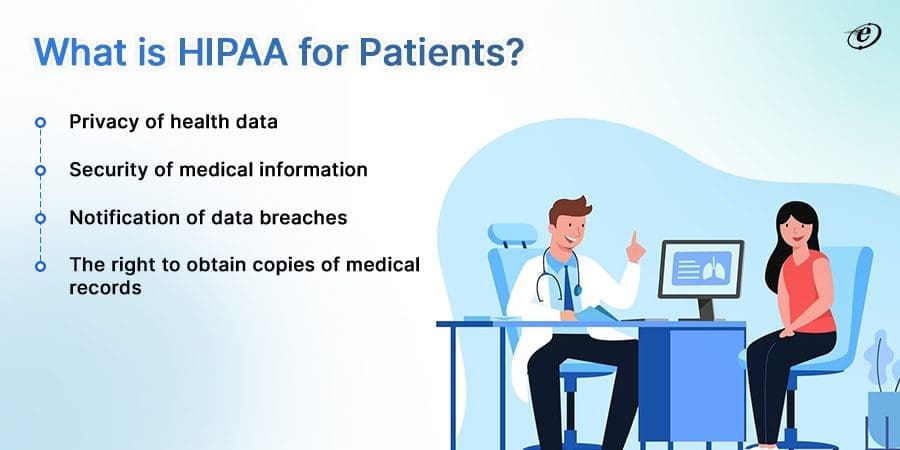
HIPAA safeguards patients against identity theft, a common crime associated with personal data fraud. Identity theft can leave a victim with big debts, significant financial losses, and dangerous false claims. The average victim of data fraud spends more than $13,000 to deal with the fallout, according to MIFA.
No organization is permitted to forward patient information following HIPAA compliances. Only healthcare professionals are permitted to disclose patient information to stakeholders.
Since patients have full access to their medical information, entities should notify them of any breaches. Additionally, it enables smooth data exchange between multiple healthcare organizations.
Benefits of HIPAA for Hospitals

What happens if a hospital doesn’t comply with HIPAA regulations? Massive fines of around $1 million will be charged. There are numerous instances of hospitals being penalized because their hardware or software was poorly secure.
For example, a Massachusetts hospital was hit with a $218,000 punishment in 2015 for putting the data of roughly 500 patients in danger because the application didn’t adhere to the fundamental HIPAA security rules.
Another pertinent example is the $3.2 million fine imposed against the Children’s Medical Center of Dallas for failing to encrypt all data on portable devices.
The HIPAA compliance application development shields our patients’ data from such severe penalties. Medical organizations must abide by several regulations set out by HIPAA to protect PHI and enhance healthcare administration.
How to Check if Your App Needs to be HIPAA Compliant?
We must evaluate the apps according to three main standards to determine whether they can abide by HIPAA regulations. Those are- their category, data, and application security.
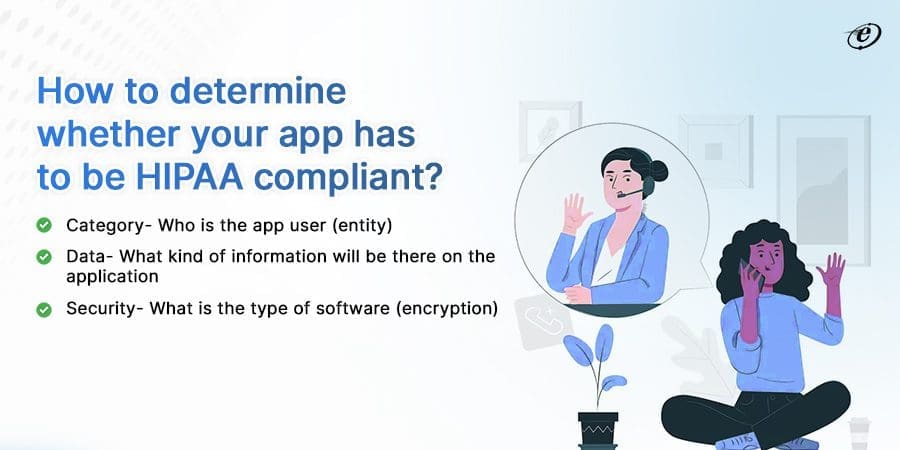
-
Who is the app user?
An application is most likely under HIPAA compliant app development standards if employed by a covered authority, such as a hospital, physician, or health insurance provider. Consider, for instance, if your app promotes patient-doctor interaction because both hospitals and medical practices are considered protected entities, you must go for HIPAA compliant app development.
On the other hand, an application that aids a person in maintaining a prescription schedule would often not be required to abide by the HIPAA privacy requirements because no protected individuals are involved.
-
What types of data will be included in the application?
Any medical information that can be used to categorize a person, PHI, and knowledge that was created, used, or reported at the time of providing a healthcare-managed service, like diagnosis or treatment, are all specifically dependent on compliance with HIPAA.
PHI is divided into two categories: individually identifiable information and medical information. It’s essential to remember that information only qualifies as PHI when personal identifying information is linked to medical knowledge.
-
What kind of software is it? (encryption)
The final factor to consider when determining whether the Healthcare app development is subject to HIPAA regulations is related to the technology employed and consists of many specifications for the security and management of electronically protected health information access (ePHI). Most of these standards are guidelines for honesty, audit, and access.
Don’t delay making your app HIPAA compliant if it comes under its guidelines and save your hospital from huge penalties. Let’s dive deeper into how to make an app HIPAA compliant.
How to make an App HIPAA Compliant?

-
Transmission Security
Transmission security ensures that PHI is encrypted during transmission over the app network. When starting an HTTP connection with your application, the browser asks for your certificate. After verifying its legitimacy, the client begins the so-called SSL handshake. This result in a secure channel of communication between your application and the user.
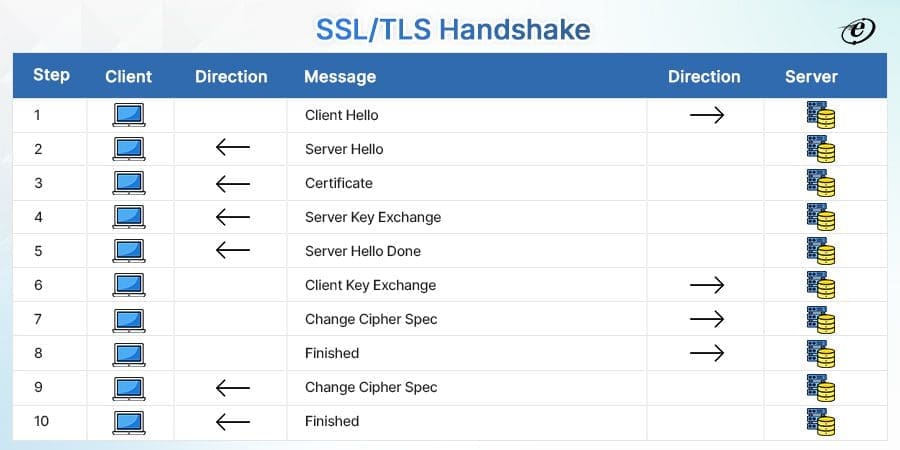
*Get an SSL certificate from one of the reputable providers and install it correctly to enable HTTPS for your app.
Make sure to send PHI-containing files via the secure SSH or FTPS protocol rather than the regular FTP. Popular services like Gmail don’t offer the required level of security. Emails containing PHI should be encrypted before being sent outside a firewall server. Numerous services and browser add-ons are available that can help you with this.
-
Access Control
Only authorized medical personnel may access patient information and records, which is one of the most significant HIPAA requirements. Unfortunately, there are many instances of internal espionage in the healthcare sector.
Any system that keeps PHI should restrict who can access or alter private information. The HIPAA Privacy Rule states that no one should have access to more patient information than is necessary for their job. De-identification, patient rights to view their data, and the ability to grant or restrict access to their PHI are also covered by the rule.
Checking who has access to PHI is the first security rule of thumb. Ensure that the app’s data is only accessible to authorized users (including third-party HIPAA-compliant software):
Access to the app can be restricted in a variety of ways. You might choose biometric or certificate-based authentication or employ multi-factor authentication, which calls for two or more methods to identify a person. Logging off automatically is a further efficient strategy which we will discuss later.
-
Encryption
The best way to guarantee PHI integrity is through encryption. All PHI-related data must be encrypted at rest and in sync in order to comply with HIPAA.
Data encryption of this kind ensures data security during data transfer and deters hacking. Without the decryption keys, even if hackers could steal your data.
Although HIPAA doesn’t specify any specific encryption or decryption standards, we prefer to use the open-source, highly regarded AES 256-bit encryption, OpenPGP, and S/MIME.
Laptops and other portable devices that are not encrypted are common sources of HIPAA breaches. Encrypt the hard discs of any devices in which PHI is to be protected. You can achieve this using free encryption software like FileVault for Mac OS or BitLocker for Windows.
-
Entity Authentication
Knowing who is accessing PHI is the next step after granting app access. One of the simplest forms of authentication is a password. Unfortunately, it’s also among the easiest to break. 63% of data breaches, according to Verizon, are caused by stolen or weak passwords. According to another study, one-fifth of corporate users use passwords that are easily cracked.

However, a perfectly secure password includes capital letters, digits, and special characters, with at least 8 to 12 characters. It also prevents the reuse of passwords.
The HIPAA compliant app development provides the following authentication techniques:
-
Biometrics Authentication
The usage of biometrics for authentication will significantly improve user accessibility. The individuality of the human voice, face, and print contributes to a better level of security while streamlining the sign-in procedure.
-
2FA or Two Factor Authentication
The 2FA is a particular type of multi-factor authentication (MFA) that increases access security by requiring two ways to confirm your identity One or more of these criteria, such as a username and password, as well as something you possess, such as a smartphone app, may be used to validate authentication requests.
-
Data Backup & Storage
During HIPAA compliant app development, a backup and recovery mechanism is a must rather than an option. A backup that is safe and secure is the foundation of security for preventing data loss. Additionally, backup data must be encrypted.
Regardless of the HIPAA app storage mechanism’s trustworthiness, there is no guarantee of security. Most issues caused by data loss can only be prevented with a timely backup. Making a complete copy of data and storing it on another medium is known as data backup. The backup should ideally be kept on a server housed in a different data center. The app can only provide the highest level of data security by doing this.
Most hosting companies offer backup and recovery services to avoid data loss in an accident or disaster. Data should be securely backed up, kept, and accessible by authorized staff.
-
Audit Control
Your medical app should monitor unusual activity in addition to the previously specified security measures. Additionally, it should monitor how and who interacts with an app.
An IT audit is a crucial step in HIPAA compliant app development. Higher fines could result from a HIPAA application’s lack of audit controls. The best thing you could do is monitor what is done with the PHI you have put in your app. Keep track of every time a client signs throughout your system. You need to be aware of every action taken with sensitive data inside Healthcare IT solutions.
Monitoring can be carried out through hardware, software, or manual methods. Using a table in a database or a log file to track all patient information interactions would be an easy option.
You must periodically audit the activity logs to see if users misuse their access rights to PHI.
-
Data Integrity
It is imperative to take all reasonable precautions to prevent unauthorized damage or alteration of the information you collect, store, and transport. Making sure your system can instantly identify and report any illegal data tampering, even if just one piece has been altered, is the first crucial step in this process.
For the development of HIPAA-compliant mobile apps and other software solutions, data integrity is essential. Health apps can protect sensitive data using encryption technology and secure communication methods. They guarantee that confidential information is safe even if a breach happens because it cannot be decoded and read.
Along with using SSL/TLS protocols and a secure HTTPS connection, it’s critical to transmitting PHI using Healthcare Messaging Standards like HL7, FHIR, CDA, DICOM, etc. Remember that data needs to be secured both during storage and transit.
-
PHI Disposal
During HIPAA compliance application development, it is advised to put all patient health information in a separate database. This will prevent you from repeatedly encrypting and decoding every byte of the application, which could occasionally cause it to run slowly.
PHI disposal is one of the HIPAA requirements for the software. When PHI is no longer required, disposal implies that it will be destroyed. If copies of the information are in any backups, the information cannot be regarded as being disposed of. Therefore, preventative procedures must restrict incidental and avoid unlawful uses and disclosures of PHI, including those associated with the information’s disposal.
Before you discard or give away the PHI-containing media, you should appropriately destroy them and wipe the data off them.
You have three options for erasing data: overwriting it using software like DBAN, physically destroying the drive, or magnetically erasing it.
-
Automatic Log off
Users frequently overlook logging out of the app, allowing simple access to PHI. Such an error can raise the possibility of occasional manipulation of personal data or unauthorized use by someone else if the device is used concurrently. The system automatically logs the user out of the system after the user’s session is finished to protect the information stored in the user account.
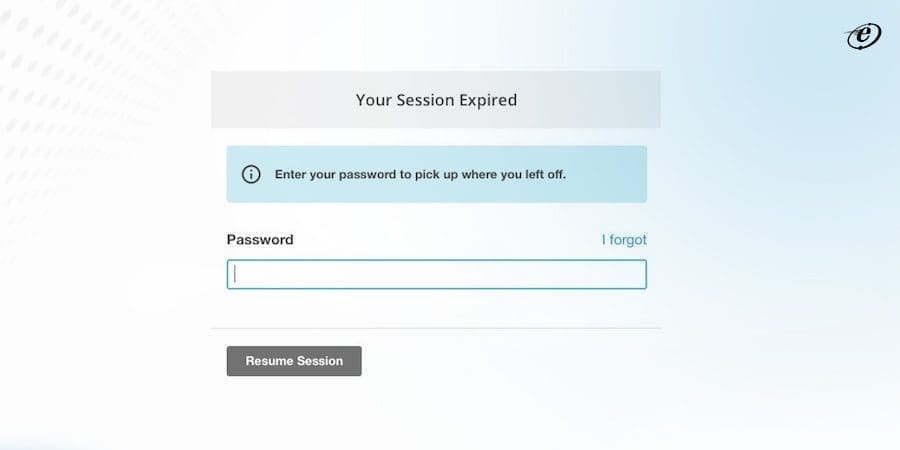
A PHI system should automatically terminate any session after a predetermined amount of inactivity. The user would need to input their password again or obtain authorization in another method to proceed.
If someone loses their device while logged into your app, this will safeguard PHI. The specifics of your system should determine the precise length of inactivity that initiates the logout.
Step-By-Step Guide for HIPAA Compliant App Development
We assume that if you are reading this, you are aware of what HIPPA is, as well as the need for HIPAA compliant app development. It’s time to look into how to build HIPAA-compliant apps. Follow the steps listed below to create a chatbot, a doctor appointment app, or any other healthcare IT solutions
If you follow these best practices and put your app through mobile app security testing, you’ll have done your due diligence at least in part.
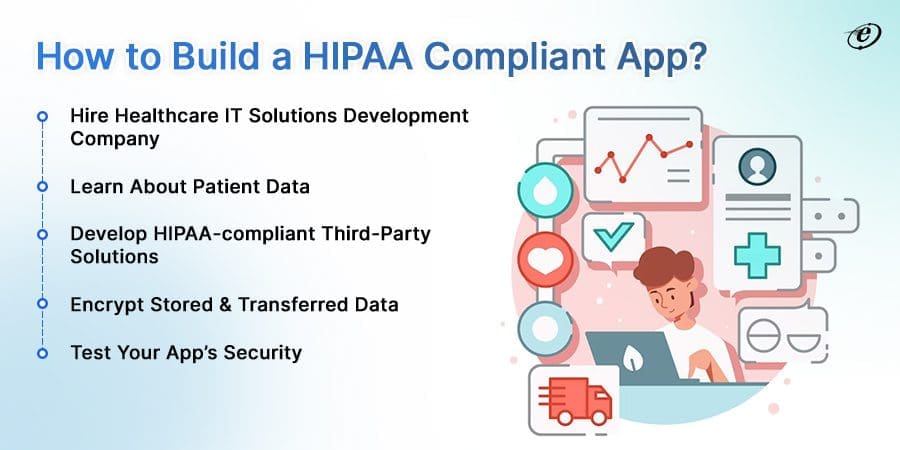
-
Hire a Healthcare IT Solutions Development Company
Unless you have the requisite experience, you won’t be able to adhere to all the necessary HIPAA rules without the assistance of a professional developer. Therefore, it is best to hire dedicated developers who can support you with crucial consultations and system audits.
It’s always preferable to consult with and have your system audited by an outside specialist. You should seek an expert; it would be beneficial whether you are a startup or a well-known healthcare company. Well, there are lots of options on the market. We at eLuminous technologies provide word class HIPAA-compliant healthcare IT solutions at the best market price.
-
Learn About Patient Data
Access to private patient information will be available to all healthcare organizations. A mobile application can store, exchange, transmit, or preserve this data.
Make sure you need all the patient data you collect, and determine what information qualifies as PHI. See what PHI data you can avoid keeping or transferring through your mobile app after you’ve done that. The first step in developing an app is to design the database correctly.
-
Develop HIPAA-compliant Third-Party Solutions
It costs a lot of money (around $ 50,000) for HIPAA compliant app development from scratch (Learn about Telemedicine App Development Cost). This cost will cover developing a system that complies with technical and physical security standards. Additionally, you’ll need to pay money to audit this system and obtain all relevant certifications.
Instead of creating HIPAA-compliant mobile apps from scratch, the easiest way to save time, money, and effort is to use the infrastructure already in place and HIPAA-compliant solutions. For example, HIPAA-compliant companies like Amazon Web Services and TrueVaul are in charge of maintaining data security.
You must execute a business partner agreement with third-party businesses and confirm their dependability before using their services for storing or managing PHI data.
-
Encrypt Stored & Transferred Data
Encrypt your patients’ sensitive data using security best practices. Use multiple encryption and obfuscation levels to ensure there are no security lapses. To prevent saved data from being taken from a device, be cautious when encrypting it.
To encrypt your patients’ sensitive information, you must apply security procedures. During development, using blockchain technology can assure data confidentiality and integrity.
-
Test Your App’s Security
Risk elimination is a goal that can’t be compromised for your business or your customers. You must perform testing after each upgrade to ensure the documentation is updated. Make sure to test your application both statically and dynamically.
To keep your app secure, you must run a regular maintenance routine. Frameworks, libraries, and tools facilitate the development of healthcare applications and provide ongoing security updates. For example, you should be sure to routinely update any mHealth apps you create after ensuring they are HIPAA-compliant, as failing to do so could result in a security breach.
How can the eLuminous Team Help You?
Insurance companies and hospitals now frequently use mobile applications to link patients with doctors and track their health. These latest mHealth apps must follow HIPAA compliant app development guidelines. Concentrate primarily on security measures to safeguard PHI and ensure data integrity.
During HIPAA compliance application development, always consider how much data is actually necessary for your app to function and benefit users. If your app collects information that isn’t required, you’ll be using resources to protect data you don’t truly need.
eLuminous Technologies has extensive experience in HIPAA compliant app development backed up by deep expertise in the industry. The company’s technological know-how will assist you in creating reliable eHealth software that complies with all HIPAA requirements.
While working on your software development project, we’ll be delighted to assist you in achieving HIPAA compliant app development, whether you’re a healthcare provider, business associate, or a member of a covered entity.
Get a free consultation if you have a specific project in mind!



